Learning Outcomes
After this course, participants will be able to:
- Discuss reasons why there would be a potential increase in fittable patients by the inclusion of the BTE PP and T-coils in the Opn family.
- Identify patients who can benefit from the inclusion of Tinnitus Sound Support in the Opn product line.
- Describe the audiological conditions under which Speech Rescue can bring additional benefit to Opn users.
- Describe the overall patient benefit of the Opn product family.
Opn: Introduction and Overview
I want to take a few moments to review key aspects of the Opn product line. The most important aspect of Opn is the OpenSound paradigm. This gives patients the ability, when they are in complex environments (with multiple sound sources, multiple speakers), to have a broad view of the sound environment and to have access to the important speakers in that environment. This is achieved without having to create a narrow, restricted listening range, and allows patients to perform effectively in these environments.
Over the years, patients have struggled in complex environments, and progress has been made in this area. However, it seemed to us that the only new development in the past several years was beamforming. We didn't feel that beamforming was the way we wanted to go as a company as it seemed too restricted and too unnatural. We wanted to give patients improved performance in complex environments, but we wanted to do it in a way that was more natural than the narrow listening field that you get with beamforming. As a result, we put together OpenSound Navigator, creating the OpenSound paradigm, where patients have the ability to perform better in these complex environments, but without having to deal with what we call tunnel hearing, or beamforming.
The OpenSound paradigm, and the Opn products, are all on the new Velox platform which provides significant increase in processing power and processing speed. It allowed us to be able to implement a computationally-heavy sound paradigm, or signal processing paradigm, which is the OpenSound Navigator.
The release of Opn was accompanied by solid research to show that not only were we improving speech understanding performance in noise by 30%, but that this improvement in speech understanding in noise related to how hard listeners had to work in complex environments. We are able to show both physiologically and behaviorally a reduction in listening effort to perform the core task of speech understanding in noise, and it allowed us to free up other processing resources for patients to do more with those conversations, to embed themselves in conversations, and to simply be able to participate at a much easier, effortless and natural level. For more details, refer to the white paper, OpnTM Clinical Evidence.
Last fall, we expanded the Opn product family from not just Opn 1, which is the premium product, but also Opn 2 and 3. Opn 2 and 3 come in also in the middle and premium categories; they allow hearing care professionals to have more price flexibility when patients have limitations on their budget. Later in the seminar, I will spend a few moments getting back into the differences between Opn 1, 2, and 3, for those of you who are not familiar with the full range of products we have in the Opn family.
As part of the Velox platform, Opn is the first hearing aid that is able to include both types of wireless systems into the same hearing aid. For a number of years, hearing care professionals had to choose between using a radio Bluetooth-based system or using a magnetic-based system, near-field magnetic induction. There are advantages and disadvantages to both wireless systems. With the Velox platform that we released last year, we were able to successfully launch a platform that included both wireless systems in the same platform. This allowed the benefits of both systems without the drawbacks of either system.
The OpenSound Paradigm
In many environments, the speaker of interest isn't necessarily always directly in front of the person with hearing loss. If the speaker was directly in front of them, beamforming would be an adequate solution. However, in many naturalistic situations, there are speakers coming from multiple directions. We wanted to allow the patient to have improved performance in these environments, but without having to close off the world of sound around them. Because of the way OpenSound Navigator combines directional behavior with effective noise reduction behavior, it has allowed patients to be able to be in these more open environments, and at the same time, reduce non-speech signals in the environment. We have achieved our goal of allowing hearing impaired patients to interact more naturally in true, complex listening environments, without requiring them to be facing the only person talking in the room. The simple fact is there are so many environments that are enriched and fun and socially pleasing, where multiple people are talking. Hearing impaired people deserve to have access to that type of naturalistic listening experience, and we were able to achieve that with OpenSound Navigator.
OpenSound Navigator
OpenSound Navigator has three stages to processing. The first is an analysis of the environment. Before we can begin any reduction of the competing sound sources in the environment, we have to know what those sound sources are. The heart of what is different about OpenSound Navigator is the way that it updates its analysis of the environment. It has 16 channels, which can analyze the environment one hundred times per second, and defines the signals in those channels based on a variety of different acoustical dimensions. This process allows for a relatively accurate description of the primary speech sources in the environment and the non-speech sources in the environment. That information is then used to drive directional behavior in the device, to allow preservation of dominant speech sources in the environment, and attenuation of non-speech sources in the environment. That is followed with an effective, new type of rapid noise removal system that allows a cleaning-up of the signal for those sources of sound that are not identified as dominant speech sources. The combination of these three stages of processing allows the patient to have access to multiple talkers in the environment, but still allows for improved performance, because of the ability to eliminate the extraneous, unwanted sounds.
In order to improve speech in noise, we have to find a way to differentiate the desired sound source (e.g., speech) from the non-speech sources of sound in the environment. In order to do that, it became clear that we needed to collect data to make decisions. We need to be able to analyze the environment, classify the sound sources in the environment, and then make very rapid decisions about what we want to preserve and what we want to eliminate. The hearing instrument can only respond as quickly as the data allows. Because of the processing power that we have in the Velox platform, we were able to implement OpenSound Navigator, which significantly improved all three of those areas.
The difference in OpenSound Navigator compared to other signal processing approaches that use directionality and noise reduction, is that we can leave the sound scene open, because we are far more effective at eliminating noise. The heart of what allows us to keep this OpenSound experience for the patient is the ability to rapidly differentiate speech from noise signals in the environment, and attenuate the noise signals with updates over a hundred times per second. We have a unique way to define speech and noise, and that's what sets this system apart. In the analysis function, the way it uses a 360-degree scan of the environment allows us to specifically pinpoint the location of different sound sources in the environment, whether they're speech in noise, and whether they should be reduced or preserved. This is driven by a lot of data. The processing power in the platform allows us to gather a tremendous amount of data about the environment on an ongoing basis, and then use this data to drive extremely rapid updates in the way that both the directional behavior of the product works and also in the way that the noise removal of the system works. OpenSound Navigator goes significantly beyond traditional adaptive directionality and traditional noise reduction approaches, because of the speed with which it works, because of the amount of processing power that is dedicated to this system, and because of the different principles on which OpenSound Navigator works. If you are interested in learning more about OpenSound Navigator, I encourage you to listen to the course, A Deeper Look at OpenSound Navigator, that I recorded during 2016.
BrainHearing
The basis of all of our development work is something that we refer to as BrainHearing. The main idea behind BrainHearing is to make smart decisions about signal processing that allow patients to function in complex listening environments, with less cognitive load and less cognitive effort. Understanding speech is just the beginning of the cognitive processes that occur when you are engaged in conversation, or engaged in a learning environment, or any place where speech is being used. You want to process that information. The harder you have to work to decode the signal, the less cognitive capability you have left over to interpret and use the information. One of the fundamental drivers of all of our development is BrainHearing, through which we are trying to feed the person's brain the most relevant information from the speech environment, in order to provide the most benefit.
When we developed OpenSound Navigator, we tested the effect using both traditional speech understanding measures, and showed up to 30% improvement compared to our previous high-end products. In addition, we also showed a physiological reduction, as measured by pupil dilation, in the amount of effort that had to be expended in order to achieve that level of speech understanding. We were also able to demonstrate that the patients were using less effort to understand the words, because they were able to do a secondary cognitive task (word recall) more effectively. We could have measured it in a variety of different ways, such as depth of processing, complexity of the information presented. However, we were trying to demonstrate that if you don't have to work as hard to understand the words, then you have more capability to do other cognitive tasks with the information that you hear. When we talk about the 20-20-30 data, we're talking about the ability to not only improve core speech understanding performance, but also to improve the ability for the patient to do things with the information that they now understand.
As I said, Opn was the first product on a platform that included both NFMI and 2.4 GHz Bluetooth technologies. That achievement allowed us to bring the benefits of both of those systems, without the inherent drawbacks of either. This capability has continued to be the gold standard that the rest of the industry has been striving to achieve: having both wireless systems on board in the same product.
What's New
miniRITE-T
In the spring of 2017, we released new products in the Opn family (Figure 1). Up until now, the only model that has been available in Opn 1, 2 and 3 has been the miniRITE. This spring, we introduced the miniRITE-T, which is a slightly larger-body miniRITE that allows for a T-coil. The miniRITE-T is slightly larger than a miniRITE, but dimensionally, it is still within the miniRITE family. It has a slightly different design, including a rocker switch. We have also introduced the BTE 13 Plus Power, a classic BTE style that can be fit using either a traditional ear hook and ear mold, or a thin tube (a.k.a., Corda). What also makes this unique is an LED on the product. This is the first time outside of the pediatric family where we've included an LED on the hearing aid. This is an important indicator for caretakers of people who wear hearing aids to know whether or not the hearing aid is functional and working. It is a feature that can also be disabled when the product is fit by the hearing care professional.
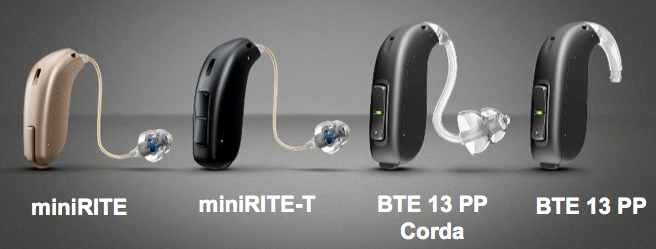
Figure 1. Oticon Opn new styles.
Rechargeability
We are pleased to announce that the miniRITE products that have been on the market for the past year are now rechargeable. Going forward, you have the option of ordering miniRITEs that would include a rechargeable battery compartment. For any Opn miniRITEs that have been fit since we released Opn in 2016, they can be retrofit and converted into rechargeable products, simply by exchanging the battery drawer on the product. That's something that can be done either in your office or by sending it in to the Oticon facility. To get more into the logistics of how to handle that, I will encourage you to talk to the Oticon representative, but you should know that the rechargeability within our miniRITE family is both going forward and also for products that have already been fit. This is a nice feature to offer to your patients who were previously fit, and are interested in rechargeability. I will further discuss rechargeability in a few moments, but before I do that, I want to talk about a few other aspects that will be new this year.
Speech Rescue
We have introduced Speech Rescue, which is our approach to frequency lowering, in all of the Opn products. It is driven by a firmware update, and so, products going forward will have Speech Rescue as a feature that you can activate. For Opn products that have been fit over the last year or so, if you choose to include Speech Rescue, you can do so simply by installing a firmware update.
Tinnitus SoundSupport
We have had a popular and successful approach to tinnitus that we've been using for the last couple of years. The tinnitus capabilities, Tinnitus SoundSupport, and all of the support materials available will now be available in the Opn products. Similar to Speech Rescue, Tinnitus SoundSupport is not only for products going forward, but it also can be updated for Opn products that you have fit already simply by doing a firmware update. The course Oticon Tinnitus SoundSupport provides an overview of the core elements of Tinnitus SoundSupport, a review of how it is used in Genie, and discusses the Tinnitus Sound App as well as educational and support materials.
Focus on Teens
The third major component about our program is a focus on fitting Opn products to teens. Originally, the Opn product family did not have all of the capabilities that made them a natural choice for children, especially young children. But with some improvements in the product line, we believe that this is an important time to talk about the relevance of fitting Opn to teenagers and other children, where the use of FM is not the primary concern. I'll talk a little bit more about all three of these features, as we go throughout the course of the hour.
Fitting Ranges
In Figure 2, you can see the fitting ranges for the BTE Plus Power, the miniRITE with the 100 speaker, and the miniRITE with the 105 speaker. The greatest fitting range is with the Plus Power, which has the T-coil. For patients who come close to that fitting range, you'll also have the 105 speaker that can be used on the miniRITE. Both of those reach down well into the severe hearing loss category. Even the 100 speaker also does a pretty good job of reaching down into that level of hearing loss. As far as being able to provide solutions for patients with severe bordering on profound hearing loss, we have a couple of different choices within the Opn product line. Because of the inclusion of a T-coil in the BTE Plus Power 13, that is probably the most fully capable product that you can offer to patients with severe hearing loss.
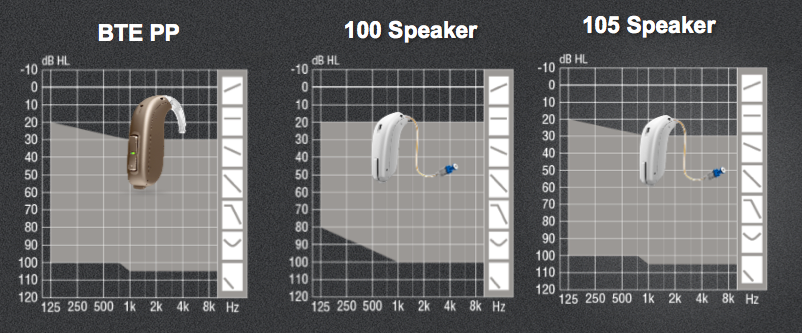
Figure 2. Fitting ranges.
ZPower Options
The ZPower company is our current supplier for rechargeability. The use time with the rechargeability on Opn is as follows:
- No streaming = 18-19.5 hours
- 90 minutes of iPhone streaming = 16-17 hours
- 4 hours of TV + 1 hour of iPhone streaming = 15-16 hours
We only wanted to go with the rechargeable solution once we were fully confident that it could reach the number of hours of use that patients were going to need. Without streaming, we can exceed 19 hours per day, which pretty much fills up most people's days. If the patient spends some amount of time streaming, whether on the phone or watching television, we can still fill up most of the day on a single charge. The nice thing about the ZPower solution is that it allows the patient to swap out the rechargeable battery for a standard zinc-air battery, if for some reason they failed to charge the hearing aids overnight. We wanted to offer our patients that assurance, which is one of the nice features of going with the ZPower solution.
ZPower offers a silver zinc solution. It is one of the more environmentally-friendly batteries available in the marketplace. It's also the first rechargeable hearing aid that allows for 2.4 GHz direct streaming. Some of the early rechargeable products on the market did not allow for streaming. Most importantly, it is the only rechargeable product that has OpenSound Navigator. We never want to lose sight of the fact that driving the success of the Opn product family are the capabilities that OpenSound Navigator brings to patients with hearing loss. As stated earlier, miniRITEs that have been previously fit in the Opn product family can be retrofitted with a simple change of battery drawer. If you want to find out more about the logistics of that, I would encourage you to talk to your Oticon representative.
Firmware Updates
Both the tinnitus solution and the frequency lowering solution are driven by firmware updates. Just like with smartphones, much of the capability that is in hearing aids these days is driven by firmware, as opposed to hardwired solutions in the hearing aids. In fact, the Velox platform is the first time that we've released a hearing aid that is totally firmware-based. In other words, the platform is totally reconfigurable, based on firmware. Every time that we have new capabilities that we want to offer in the product, we can do that based on firmware updates. The inclusion of Speech Rescue and the inclusion of Tinnitus SoundSupport are two very good examples of being able to update the capability of hearing aids simply by changing the software that's embedded in the hearing aid itself.
The other nice thing about firmware updates, and the reason why it's going to be part of the life of hearing care professionals going forward, is that the smartphone companies are constantly doing updates to their own firmware on the products. In order for hearing aids to continue to be compatible with smartphones, we have to keep pace with the firmware updates that the cell phone companies use. We never want to allow patients to fall behind in capabilities on connectivity, because the manufacturer of the smartphone has changed something about how their operating system works on the product. Going forward, it will simply be a fact of life that hearing aids have to be updated in order to keep pace. As an industry, we are coming to terms with that, and we are continually working to find simpler, more convenient, and more effective ways to upgrade the capabilities of our products via firmware updates.
Speech Rescue
One of the important aspects of the firmware update this time is to include Speech Rescue. Speech Rescue is a technology that we introduced into the marketplace a couple of years ago. It is our take on frequency lowering. Going forward, all Opn products purchased in any of the models will have Speech Rescue as a feature that can be activated, if desired. By default, Speech Rescue is set in the "off" position on Oticon products; you must manually select within the Genie software that you want it turned on for the patient. Again, Opn products that have previously been fit to patients can be updated with Speech Rescue.
Frequency Lowering Approaches
There are a variety of frequency-lowering approaches currently available in the marketplace. Historically, the most popular approach in terms of the number of fittings that have occurred, is frequency compression. With frequency compression, you are taking a broad range of sound up in the very high frequencies and compressing it in the frequency domain down into the mid frequencies. That approach to signal processing did not impress us as the most effective way to provide access to important speech information from the high frequencies. We felt that was a little bit too aggressive and too disruptive of the speech signal. In response, we developed something called Frequency Composition. With Frequency Composition, we are approaching the goal of trying to get important information in the high frequencies more audible to the patient, but in a different way than frequency compression.
To explain in more detail, with frequency composition, we identify important frequency regions in the very high frequencies that we believe carry important speech information that may be inaudible to the patient. Then, we replicate that information down in the mid frequencies, where it should be audible to the patient. At the same time that we copy that information down into the mid frequencies, we keep the original information in its position up in the high frequencies. Essentially, what we want to do is give the patient two opportunities to hear that information in the high frequencies, both in its natural position in the high frequencies, and in a replicated position down somewhere in the mid frequencies, because we believe you never know what cues the auditory system is going to detect. If this information in the high frequencies is inaudible, then it's inaudible. However, given that speech comes through at different levels at different times, you never know what's going to be audible or inaudible to the patient. By being able to use a copy and keep approach, that allows us to offer the patient's cognitive system more access through the information in the speech signal. Compared to the frequency compression, we like this approach because it's not an overly aggressive treatment of the speech signal. It's keeping most of the speech signal where it belongs naturally in the spectrum. We don't want to disrupt the natural cues any more than we absolutely have to, but it does provide access to important speech information from the high frequencies in a region where it should be more audible to the patient.
The idea with Speech Rescue (Figure 3) is to take this naturally-occurring speech sound (S) in the high frequencies, that even after amplification may not be audible to the patient, and replicate it down into the mid frequencies and amplify it above threshold. At the same time, we are keeping the original sound up in the high frequencies, and amplifying that as called for by the fitting rationale. Our goal is give the patient access to two versions of the speech sound: the version that has been moved down to the mid frequencies and that should be clearly audible, and the one in the high frequencies that may or may not be audible (i.e., useful). Since there's typically never a drawback to having that speech sound up in the high frequencies, we keep it there. Interestingly, if you are not familiar with our frequency lowering technology, you can turn off the high frequency part of the signal and only maintain the mid-frequency moved copy of the information. We believe that this is a more sensible and appropriate treatment of the speech signal, by not trying to disrupt too much of the speech spectrum and yet allow greater access to the speech sounds that the patient is going to find useful.
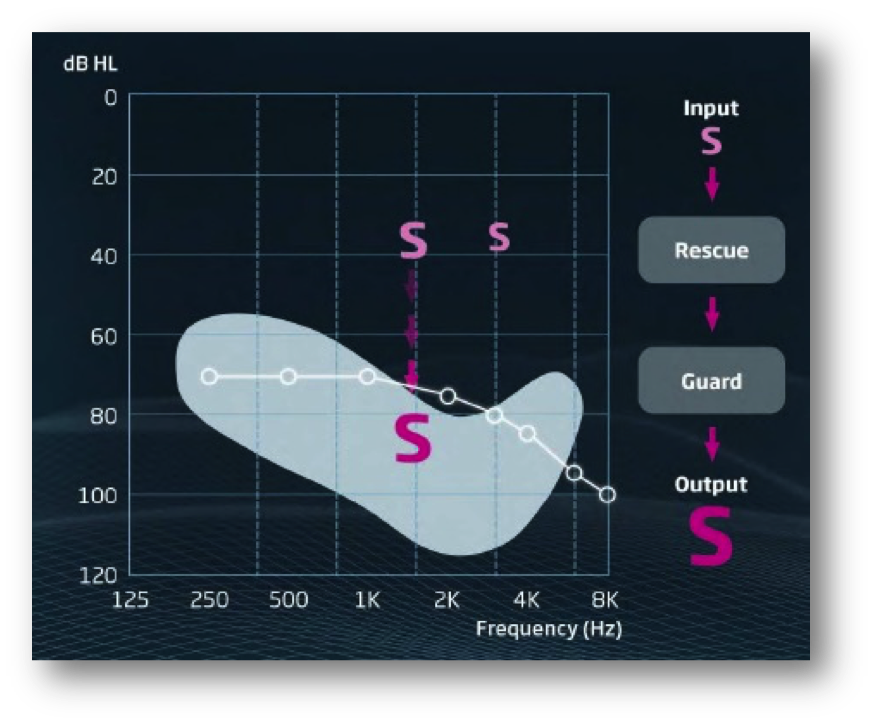
Figure 3. Speech Rescue diagram.
Speech Rescue Candidates
It's important, then, to identify for which patients Speech Rescue becomes most appropriate. Up to this point in time, we have only used Speech Rescue in our Super Power products (the Dynamo and the Sensei Super Power products). This is the first time that we have introduced frequency lowering in mainline products, meaning products that can be fit across a broad range of hearing losses. Of course, the most obvious candidate to wear Speech Rescue is a patient with severe or severe-to-profound hearing loss. Patients for whom you have a concern about being able to maintain good audibility in the high frequencies; then you may choose to move information down to the mid frequencies. We strongly believe that direct amplification makes the most sense for all patients. As such, by default we turn Speech Rescue off in our products. However, if you, as a hearing care professional, believe that you can improve the patient's performance by providing access in the high frequencies, then you can activate it in the products.
Now that Speech Rescue is available in mainline products, we are able to recommend Speech Rescue to our patients with steeply sloping losses (i.e., ski slope losses). That group deserves a bit more discussion about whether or not you want to use this for the patient, and I'll get right back to that point in just a moment.
The third group that would make good candidates for Speech Rescue are patients with progressive hearing loss. These patients may be able to hear high frequencies in the short term; however, due to complex medical issues that may rapidly affect hearing, if they lose access in the high frequencies, it's nice to know that you have Speech Rescue available in the product.
Severe hearing loss can have different etiologies and take on many different forms. A person may have a lot of asymmetry and instability in their hearing. One of the common characteristics is that once you get up into the high frequencies, it's difficult to ensure good audibility. Speech Rescue, or any frequency-lowering technology, makes sense for patients with these type of audiograms (Figure 4). Now that Opn comes in a Plus Power, and the fitting range has been extended down to beyond 100 dB, then it becomes very important to be able to have Speech Rescue available for patients down at this level on the audiogram.
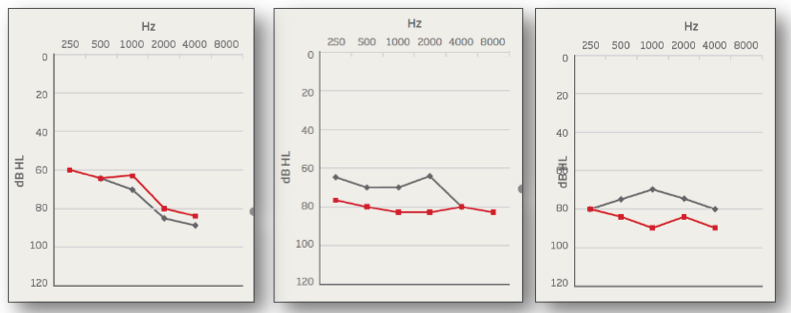
Figure 4. Example audiograms: severe SNHL.
Ski Slope Losses
With ski slope hearing losses, it is a more complex discussion about whether or not to use frequency lowering. Here is a typical ski slope fitting that you would get from Opn or any of our products, using the Voice Aligned Compression Plus (VAC) approach (Figure 5). With VAC fittings you don't see a lot of audibility in the very high frequencies for patients with steeply sloping losses, and that is by design because it would require a significant manipulation of the speech signal. Instead, what we've been doing for the last two decades with ski slope losses is providing a modest audibility enhancement in the mid frequencies. The improvement in the mid frequencies in shown in Figure 5 as the difference between the dark red and the light red shaded areas. Again, this has been the way we've been fitting ski losses for the last two decades.
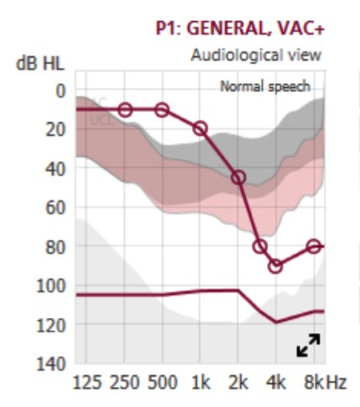
Figure 5. VAC fitting.
Patients with ski slope losses manage fairly well in quiet settings, but they struggle to some degree in noise. The problem is that they will often judge the performance of the hearing aid based on sound quality and comfort issues; because they hear well in quiet, and they have good thresholds in the low and the low-to-mid frequencies, they experience sound at an adequate quality most of the time. If you are trying to achieve a high level of audibility in the very high frequencies, what you end up having to do is probably close off the ear canal and drive a lot of gain in the very high frequencies. First of all, that high frequency emphasis is going to sound odd to the patient, with a tinny sound quality. Also, now the patient will probably have to deal with occlusion. Historically, patients with ski slope losses have rejected the amplification, because the downsides of the amplification have been greater than the upsides.
Two decades ago, when we introduced our ski fitting approach, the idea was not to try to achieve levels of audibility at 4K and above that are simply difficult to achieve; rather to focus in the mid-frequencies, where there is a lot of good speech information to be had. This was a concept that we picked up based on some Margo Skinner's work. She pointed out how important the mid frequencies were, especially for patients with steeply sloping losses, where the functional usefulness of their hearing in the very high frequencies might be limited. Because of this, we made it our goal to do fittings that were focused on not only audibility considerations, but also on comfort and sound quality considerations. That's why the typical frequency response that we would have used in ski slope losses was not as aggressive as a lot of hearing care professionals might have wanted, but it has been a very successful fitting approach. However, we do recognize that there is information up in the high frequencies that the patient might find useful. By offering Speech Rescue in products now that can be fit to ski slope losses, you now have the option of taking some of this information from the very high frequencies and moving it down to the more audible mid frequencies. Again, by default, we are not recommending that, but we do realize that some clinicians may want to do that, and so we are now making that available as a tool for Opn fittings.
The graphs in Figure 6 demonstrate a fitting for a patient with a dramatically-dropping high frequency hearing loss. In the SPLogram, the gray shaded area is the region where we grab speech information that we think is going to be useful to the patient (4 kHz up to about 7 kHz), but probably inaudible. We move it down to a region from about 1500 to 2500 Hz, where we believe that we can achieve some level of audibility for the patient. That's the way we would handle a loss like this: to copy this information in the high frequencies, and replicate it in the mid frequencies. There are a series of controls in Genie that allow you to do this. For more information and training on controlling frequency lowering in the Genie software, contact your Oticon representative. It is the first time that we've offered frequency lowering for these types of losses. Again, we would encourage you to not disrupt the sound quality and the comfort of patients who you're trying to fit with these hearing losses, because you want to make sure that they want to wear their hearing aids. For some patients who can handle more speech audibility, or handle this replicated information in the mid frequencies, it is now an option in the Opn product line.
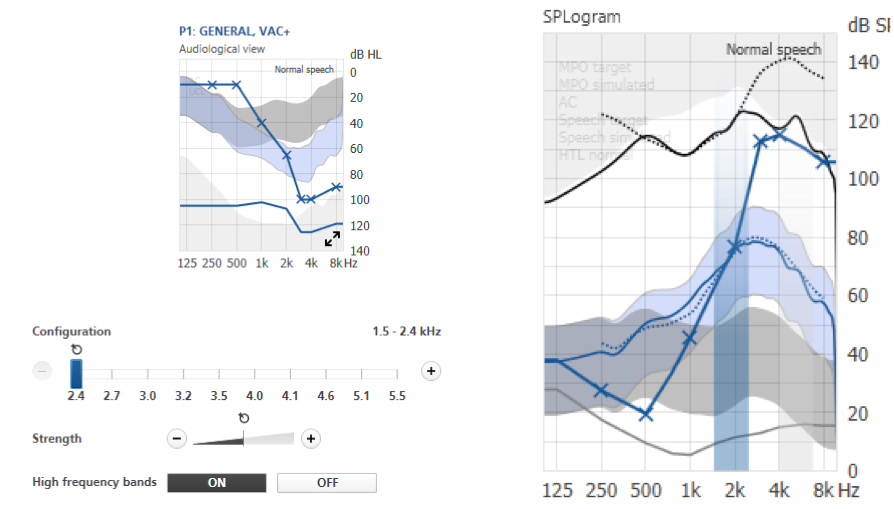
Figure 6. Fitting for precipitously-sloping high frequency hearing loss.
We believe that Speech Rescue fits nicely in the way we approach treating hearing loss. OpenSound Navigator is the first step in trying to clean up the signal, in order to provide good access to the clean speech signals in the environment, and eliminate the noise. We then use Speech Rescue to move information from the high frequencies down to the mid frequencies, for those patients who would benefit from that. Then, we amplify using our Speech Guard signal processing approach to try to maintain as much information in the speech signal as we possibly can. One emphasis of our BrainHearing approach, is that we're trying to provide as much good information to the cognitive system as possible. We believe that these three technologies -- OpenSound Navigator, Speech Rescue, and Speech Guard -- all work nicely together to provide good access to the information in the speech signal for those patients who are in a situation where high frequency information may be a little bit harder to achieve.
You may be wondering whether or not you want to recall patients who you have already fit with Opn, in order to retrofit them with Speech Rescue. We would strongly encourage you not to do this, unless you have a very particular patient who is struggling with their Opn fitting. If patients are happy with the Opn fittings, the idea of offering Speech Rescue to move high frequency information down to the mid frequencies doesn't make a lot of sense to us. Again, I'm talking specifically about patients with ski slope losses. If you fit patients with moderate-to-severe or severe hearing losses with Opn up till now, and you want to experiment with Speech Rescue, then you may want to do this. However, for patients who you fit with Opn products over the last year, and who are doing well, we do not believe that there is a need to recall those patients. Going forward, if it's something as a clinician you feel you want to offer to patients, now you have that opportunity.
Tinnitus Sound Support
Another feature that has become available in Opn products, both going forward and as something that you can retrofit in previous Opn fittings, is Tinnitus SoundSupport. We released our tinnitus package a couple of years ago, which includes a very comprehensive suite of tinnitus support sounds that can be activated in the hearing aid, plus a very nice package of support and counseling tools, for both the hearing care professional and for the patient. We are very proud to be able to offer this in our Opn products at this point in time.
There are a variety of different sounds and sound features that we include as part of SoundSupport (Figure 7). The ocean sounds have been wildly popular among clinicians who spend a lot of time fitting patients with tinnitus. It's the very naturalistic type sounds that patients tend to like. We can do things like modulate the sound and use Automatic Level Steering, in which the level of the sound is driven by the sound in the environment. All those features allow a seamless inclusion of SoundSupport in the fitting for patients with tinnitus. For the purposes of today's webinar, I'm not going to go into great detail about the way the Tinnitus SoundSupport package works in our product. If you want more information, we have AudiologyOnline courses specifically dedicated to our Tinnitus SoundSupport. I would encourage you to take a listen to those courses. As always, of course, you can also contact an Oticon representative to get more information about our Tinnitus SoundSupport fitting approach. Once you begin to find out more and start using Tinnitus SoundSupport, know that we also have a complete support package, for both clinicians and patients.
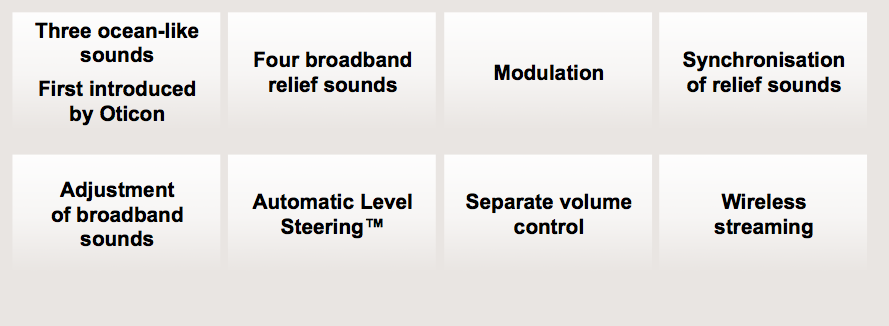
Figure 7. Tinnitus SoundSupport sounds and features.
The same question can be asked of Tinnitus SoundSupport as we asked about Speech Rescue: should we recall previously fit patients? I would suggest that you may want to do that on a case-by-case basis. If you have patients who you've fit with Opn over the past year, and if at their initial visit, they expressed concern about tinnitus, now you can choose to go back and fit those patients. If the patient has not been concerned about tinnitus, or is not reporting tinnitus, or if amplification in and of itself was enough to provide the relief that the patient was looking for, then there's no reason to recall them. It is an opportunity for you to think through the fittings that you've been doing over the last year to decide whether or not you want to recall patients. Going forward, tinnitus is something that's always available in the product, and so, for those patients who report tinnitus as a significant concern, you now have that option with Opn to be able to provide them Tinnitus SoundSupport.
New Listening Programs
Another feature that's now available in the Opn products is the idea of having listening programs. We are a company who strongly tries to make sure that one program, the main program in the product, can solve the patient's needs across a broad range of situations; but because of the T-coil and other features, we want to make sure that you do have some of the extra programs available in the products. We have eight specific listening programs that you can put into the product if necessary (Figure 8). Again, it's not a major part of our ultimate vision for the treatment of hearing loss. One of the goals that we've had for many years in Oticon is to try to make fittings as automatic and seamless as possible for patients, so that the patient does not have to do a lot of intervention. Nevertheless, we do know that for some patients, having extra programs becomes important. Now, they are available through the Genie 2 fitting software for all Opn products.
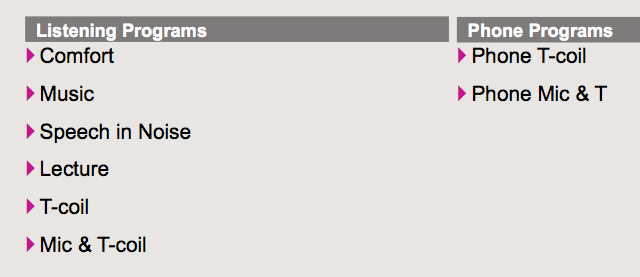
Figure 8. Eight new listening programs for all performance levels. Tinnitus SoundSupport can be added to all Listening Programs.
Teens: The Connected Generation
When we first released Opn, our previous generation of products did not make natural sense for children with hearing loss, because of the lack of FM compatibility in the product. Now that we have T-coil compatibility in the product, and now that we have things like DSL and Speech Rescue, it became time for us to reevaluate whether or not Opn made sense for younger patients. Now, we don't necessarily see Opn as a great choice for newly-identified infants or young children with hearing loss, because there are too many important needs that our dedicated pediatric product line can meet. However, as children get older and they move past the age of 10 or 12 and into their teenage years, one of the most important concerns on the part of patients and on the part of hearing care professionals is trying to make sure that the children are still motivated to use their devices. That's what we call our "teen approach." Once children get older. they tend to transition away from FM use in the classroom, possibly due to cosmetic concerns, or because of their movement from class to class around the school inhibits their use of FM. Although FM is still an option (because of the T-coil in the product), in many of these cases, Opn tends to become a more relevant and appropriate fitting for older children and teenagers.
One of the most important things about Opn that makes sense for older children and teens is the connectivity. By having the dual radio system, where you can do direct cell phone to hearing aid connection, where you can go right from the devices to hearing aids, it opens up a world of possibilities for these children. The ability to tie them into whatever connectivity that is important to them (e.g., smartphones, televisions, computers or other devices) is a very motivating factor to help keep the hearing aids on the kids. It incentivizes them to want to use their hearing aids, because they now have access to their desired media directly through their hearing aids. We thought it was a very good time to emphasize the potential role of Opn in these older children, who are starting to move away from the use of FM.
Opn 1, 2 & 3
Opn is Oticon's answer to dealing with speech and noise. Beamforming, we believed, was not the direction we wanted to go. We wanted to go in a direction where we could provide more natural access to all the dominant talkers in the environment. As such, Opn was very much a different approach to trying to solve the listening problems that patients had. We also knew that we wanted flexibility for those patients at different budget levels. With Opn 1, 2, and 3, all these products feature OpenSound Navigator. All these products feature the TwinLink dual radio approach. The difference between Opn 1, 2, and 3 is how effective OpenSound Navigator is for the patient. If a patient chooses Opn 3 (as opposed to Opn 1 or 2), they will not have quite as cleaned up of a sound environment. They will still have access to multiple speakers in the environment, but the overall effectiveness of eliminating extraneous sounds and of preserving only speech will be greater as you move up to each level of technology. Again, they're all Opn products, and they are all using a very unique approach to solving the patient's most difficult problems, without having to resort to the unnatural, restrictive approach of beamforming.
We've received reports from some hearing care professionals of asking for more guidance on how to talk to patients about the differences between Opn 1, 2, and 3. We believe that, with these four talking points, you can make a very good case for why the patient wants to be at the highest level of technology that they can comfortably afford in order to get the benefits of Opn for their greatest hearing challenges:
- It is all OPN, which is different than anything else in the market. The main discussion with the patient should be about how important Opn is, how important and unique OpenSound Navigator is to conquering the most difficult challenges faced by those with hearing impairment.
- Effectiveness in Challenging Environments. The most important difference when moving up to higher levels of technology will be the effectiveness in challenging environments. OpenSound Navigator is much more effective as you move from 3 to 2 and from 2 to 1.
- Sound Quality. The differences may also show up a little bit in terms of sound quality. The bandwidth in Opn 1 is better than Opn 2 and 3. The way it handles louder sound environments, the more impulsive sounds in the environment, is going to be better as you move higher up the technology ladder. The patient may hear it in terms of the sound quality.
- Ability to Personalize. You simply have more control as a professional in Opn 1 than you have in 2, and more control in Opn 2 than in Opn 3, to craft a solution that meets the specific needs of each individual patient.
Summary
Opn has been a significant achievement for the Oticon company, in terms of technical development, and being able to bring new products and new capabilities to patients. The combination of the new hardware in the products, with the BTE Power Plus and the miniRITE-T, along with the new software-based solutions, with Speech Rescue and Tinnitus SoundSupport, allows us to bring those benefits of Opn to as many patients as possible.
If you are interested in more information about Opn, and you want to dig in deeper into what we have to offer, I would strongly encourage you to talk to your Oticon representatives. Also, if you have any questions about any of the information in this presentation, feel free to email me. Thank you for your time and attention.
Citation
Schum, D. 2017, July). The Opn family: Meeting even more audiological needs. AudiologyOnline, Article 20396. Retrieved from www.audiologyonline.com


